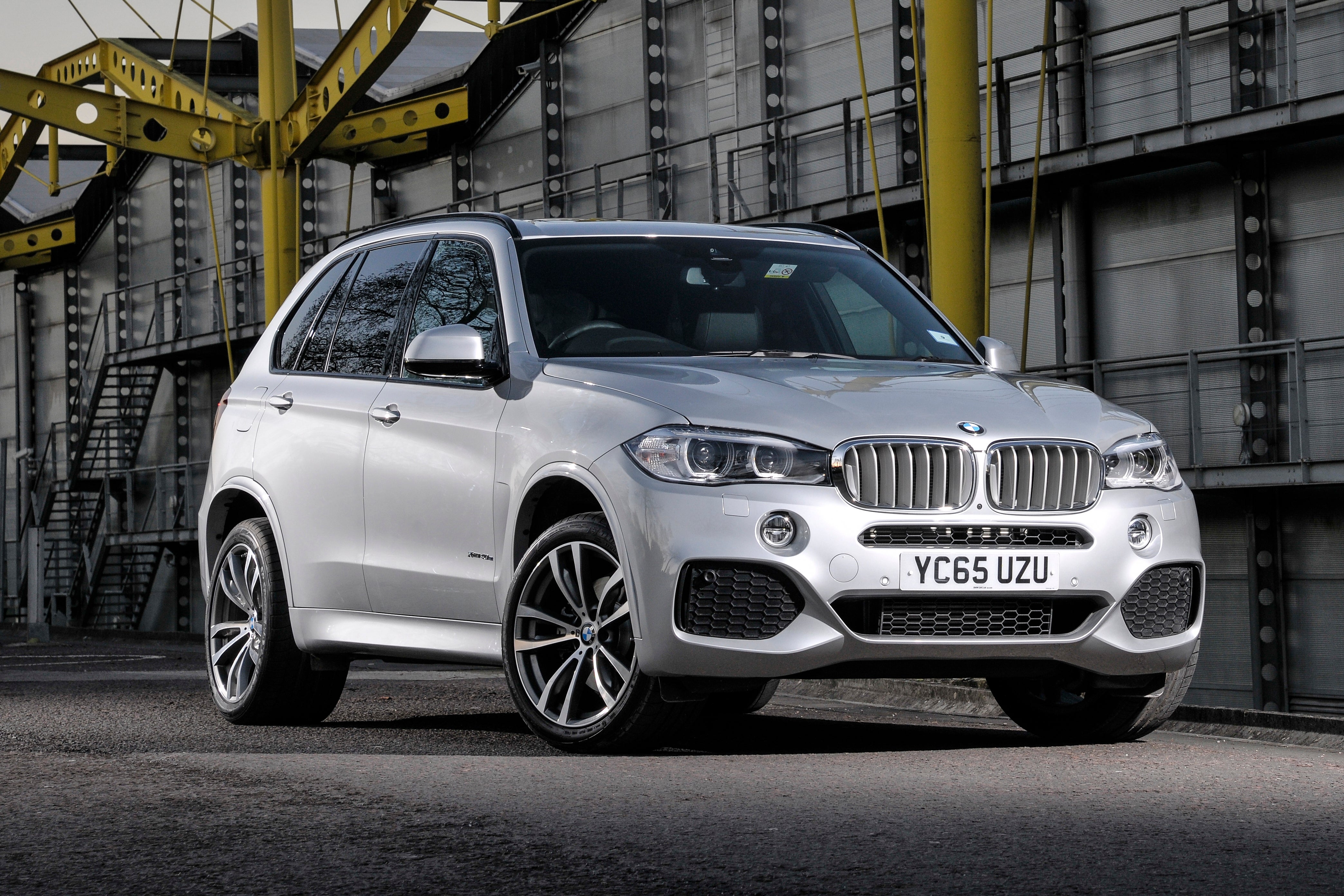BMW X5 (2014-2018) Review
Written by Andrew Brady
Quick overview
Pros
- Roomy and practical
- Enviable image
- Excellent to drive
Cons
- Styling a bit too brash for some
- sDrive versions not as capable as xDrive
- Asking prices can be high
Overall verdict on the BMW X5
"In this BMW X5 review we are taking a look at a car that has played a huge part in the SUV revolution. By putting off-road ability firmly in the back seat and concentrating on a rewarding on-road experience, the X5 delivers the space, stature and image of a large 4x4 with all the comfort and driveability of a conventional car. No wonder it's still high up on the shopping list of anyone wanting a full-size SUV."
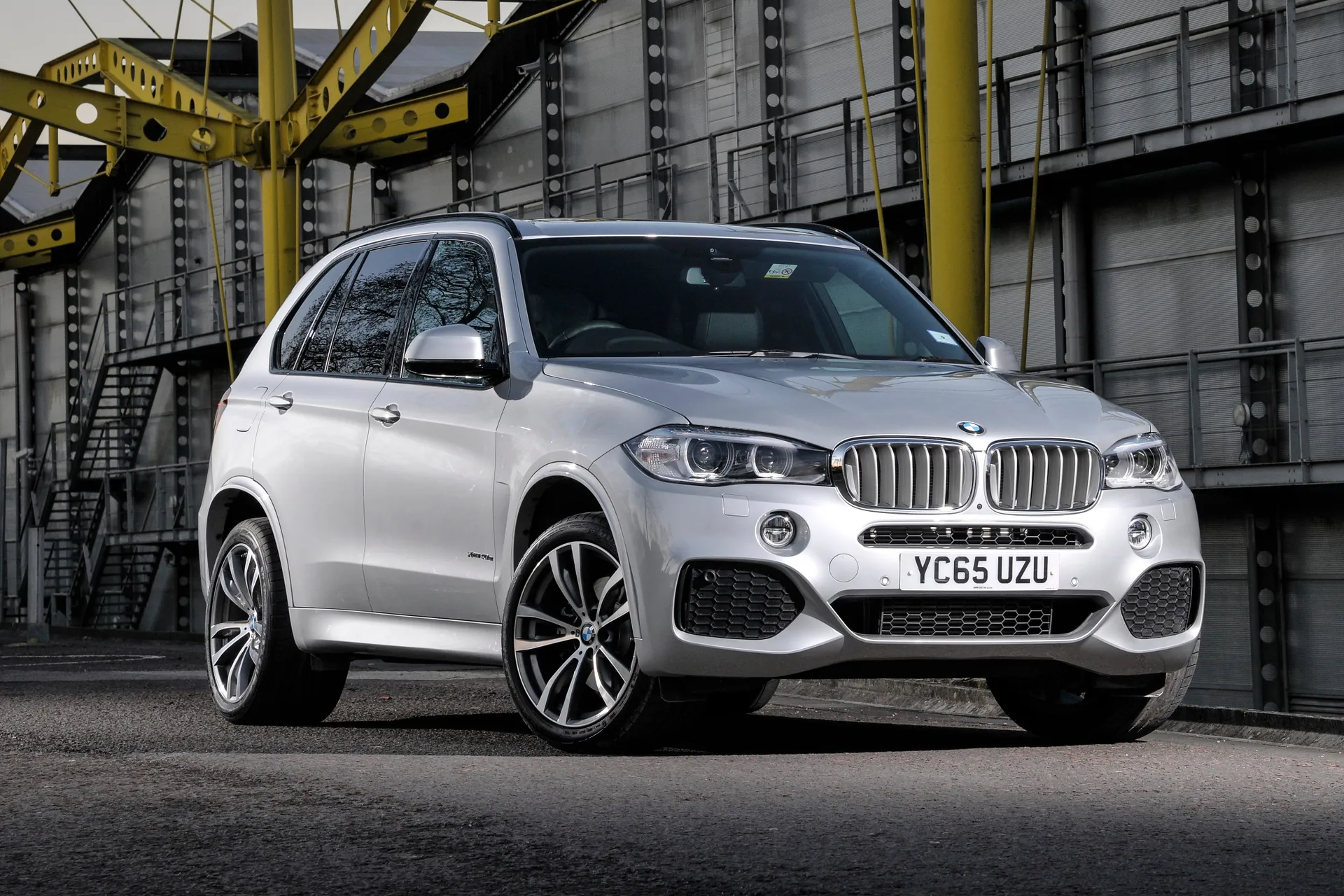
The BMW X5 was the world’s first modern premium SUV when launched in 1999. Up to that point, we’d had models such as the Range Rover for years, and Mercedes-Benz launched its ML SUV a few years before the BMW. The X5, though, was the first off-roader to deliver genuinely car-like characteristics and uncompromised on-road manners. In short, it felt anything but truck-like. BMW even tried to pretend it wasn’t an SUV at all, calling it a ‘Sports Activity Vehicle’, or SAV. Understandably, the term didn’t catch on.
The template was set, and we’ve since seen SUV sales snowball. BMW hasn’t stood still, and there have been several generations of X5 since, each one better than the last. Here, we’re looking at the 2014-2018 era model, which took the X5 to new heights in terms of refinement and roadholding, without lessening the bold SUV sensibilities that are so key to its appeal.
In response to market demand, BMW made this third-generation version the biggest X5 ever. It looks it, too, with an imposing front end and lengthy roofline. This was good news for interior practicality, however, and a three-row option even made it a surprisingly practical seven-seater.
This helped grow X5 sales further, particularly among those 5 Series drivers who were seeking a more standout alternative. BMW tirelessly researches its core and most profitable models, and the growth of the X5 justified this, helping the model become even more of a success.
Such research saw the range broaden further – surprisingly though, not at the high end (where the performance BMW X5 M50d and BMW X5 M were nudging three-figure price tags), but at the more affordable end.
This was the first X5 sold with a 2.0-litre four-cylinder turbodiesel engine, and also the first to be offered solely in rear-wheel-drive guise, rather than xDrive all-wheel drive. Prices were reduced, fuel economy improved and lower CO2 emissions meant it even became a business-friendly choice for some company car drivers – even more so when a later plug-in hybrid variant arrived.
The fundamentals weren’t forgotten, though. The X5 has always appealed to enthusiasts because it drives most unlike a traditional SUV – in other words, it has sporty, driver-pleasing traits including sharp steering, a lack of body-roll and genuine fun feedback through corners. This BMW X5 still defies logic in how nice it is to drive.
It’s an executive-class experience, too, with a plush ride quality and low overall noise levels. It’s a great long-distance machine, particularly as the high driving position and excellent visibility help instil a commanding feel behind the wheel. The xDrive models are most stable, thanks to their superb all-wheel-drive system.
Most BMW X5s of this era use a diesel engine. Britain’s high pump prices these days mean a thirsty petrol engine in a big SUV will never have more than niche appeal. The 3.0-litre six-cylinder 30d and 40d are very popular, but the aforementioned 25d did win fans as well. The range-toppers are the V8 petrol X5 M and tri-turbo X5 M50d diesel. Both are rare.
Not everyone approves of the slightly aggressive image of the X5, but there’s no denying the car itself is extremely capable and refined. Also, with second-hand prices starting to put it within reach of many more people, it’s a vehicle we predict will only grow in popularity.
If you're looking for the newer version, you need our BMW X5 (2018-) review.
Is the BMW X5 right for you?
SUVs are the car of the moment, and premium brands will always find favour among UK consumers. Combine the two into a sophisticated, expensive-looking car and the appeal of the BMW X5 is unarguable.
It’s certainly enjoyable to drive, and the economical BMW diesel engines won’t cost you a fortune to run, despite their very impressive performance. The interior is nicely upmarket and well-built as well, while still feeling classy and contemporary.
The clincher may well be its practicality. There’s loads of space for five people and a boot full of luggage, aided by a distinctive Range Rover-style split tailgate. In addition to this, the fact that you can have two extra seats – which fold flat into the floor when not in use but offer seven-seat practicality when needed – is the icing on the cake for many. It’s one reason people carriers (MPVs) are out of favour and many buyers in this sector are ignoring the traditional large estate and picking SUVs such as the X5 instead.
What’s the best BMW X5 model/engine to choose?
The model line-up is expansive, but easy to comprehend. Core models are designated BMW X5 SE, with the more desirable sporty-look versions called the BMW X5 M Sport. Within this, the range of engines comprises core 3.0-litre diesel straight-six, entry-level four-cylinder 2.0 and niche performance options such as the throaty 4.4-litre V8. Most are xDrive four-wheel drive, with the 25d also offering an sDrive rear-wheel-drive variant.
The plug-in hybrid variant (dubbed xDrive 40e) combined a 2.0-litre petrol engine with an electric motor to give strong performance, although in such a large car the economy benefits are limited and there are few examples on the used market.
Our pick of the range is the BMW xDrive 30d, ideally in M Sport trim, simply because it’s so desirable. SE doesn’t have much less in the way of standard equipment, but the styling enhancements (and larger wheels) of the M Sport are enough to win many over.
What other cars are similar to the BMW X5?
These days, there is no shortage of large luxury SUVs on the market. The Audi Q7 is the BMW’s most obvious rival, while Mercedes-Benz offers the GLE and Land Rover has the mammoth Discovery. Most Land Rover customers prefer the recent premium alternative, the Range Rover Velar.
Other choices for well-heeled buyers include the Porsche Cayenne and Maserati Levante, although both are pricey enough to make the BMW X5 seem pretty good value. One of the classiest alternatives outside the German mainstream is the Volvo XC90, which in latest guise is a genuine class act. It even offers seven seats as standard to rival the roomy BMW.
Comfort and design: BMW X5 interior
"BMW has long known how to deliver a good interior, and the X5 is a great example of the German brand’s expertise. To sit in, it feels commanding, which is a prerequisite for any SUV worth its salt. The dashboard is lower than in BMW saloons, while the side windows are larger. It feels airier to sit in and visibility is much improved, particularly looking forwards."
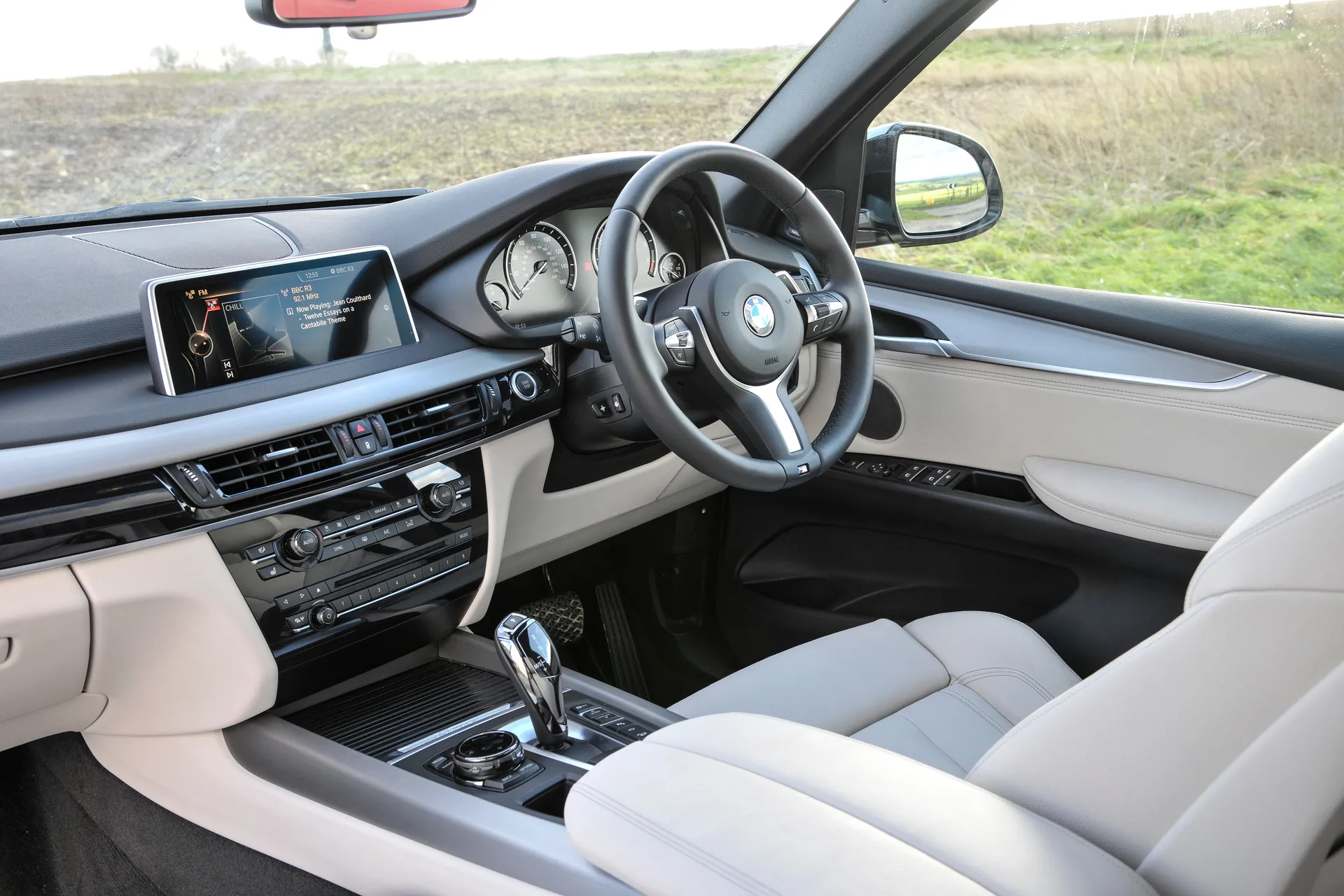
Yet it still manages to feel like an authentic BMW. There’s less of the van-like driving position you get in some SUVs, with the pedals placed further forward, so it feels more natural. The seats feel deeper and a high centre console makes you still feel like you’re sitting within the car, not on top of it.
The standard seats are Germanically firm and supportive, but we particularly like the more hip-hugging chairs fitted to BMW X5 M Sport models. They are extremely comfortable, with plenty of adjustment – including a moveable bolster to support the backs of your legs. They feel not far removed from the sort of chairs you might find in a sporty BMW M car.
The classic BMW three-spoke steering wheel is good to hold, and behind it is a set of clear instruments that are easy on the eye (and illuminate in soothing amber at night). Buttons on the centre console are logical and the widescreen infotainment screen (see below) is user-friendly.
It’s a traditional-looking layout, but also a perfectly judged one that benefits from great attention to detail. It has a timelessness that means it won’t look dated as the car ages. This should make the BMW X5 good to live with for the longer term.
Quality and finish
Like most BMWs, the X5 is built to a very high standard. This is apparent even from the outside, with excellent paint quality and perfect fit and finish. It carries through inside where occupants are presented with high-quality plastics that are rich and smooth to the touch, rather than hard, shiny and scratchy. BMW wraps the dashboard in stitched leather-effect trim, further enhancing its appearance.
All the switches and buttons work with soft-touch precision, rather than a cheap-feeling click, and details such as the instruments and ‘black panel’ climate control display have a high-clarity appearance. Standard leather is fine, but the premium leather option is a real indulgence, feeling of lavish quality.
It’s rare you’ll come across an BMW X5 that rattles or clatters on the move. BMW builds its cars to last and the X5 is particularly robust, given how its design parameters include heavy-duty off-road use. It feels like a vehicle with plenty of in-built quality.
Infotainment: Touchscreen, USB, nav and stereo in the BMW X5
BMW has led the way in infotainment for years, and the X5 is a good example of this. Even now it’s a few years old, the media system still stands up to scrutiny, which is not something many of its rivals can claim.
It’s a particularly user-friendly system to use, based around a central iDrive rotary controller. Its actions are mirrored on the 10.2-inch widescreen display, and pressing it allows users to select individual menus. It’s comprehensive, but it’s hard to get ‘lost’ within the system – there’s a ‘back’ button but you’ll rarely need to use it out of frustration.
The infotainment system is particularly high definition, with excellent mapping clarity and a user-friendly traffic alert system (jams are shown colour-coded across the sections of road, from yellow to red while green shows free-flowing roads). It’s a pity BMW is reluctant to readily integrate with systems such as Apple CarPlay, although the core system is so straightforward, it’s not such a great loss.
Infotainment was upgraded in 2016 with BMW’s latest iDrive interface. This was even simpler to use, had a RAM upgrade so it was snappier, and offers the option of wi-fi hotspot internet connectivity. Wireless smartphone charging was available, too.
Space and practicality: BMW X5 boot space
The BMW X5 feels like a large and empowering car, with a roomy driving position that is more spacious than the alternative 5 Series saloon. The dashboard is very well laid-out and the seats have plenty of adjustment.
The middle row of seats is as accommodating as you’d expect of such a large vehicle. Again, it’s more spacious than a 5 Series, with considerably more headroom and legroom. The cabin is wide, and a flat floor helps the middle-seat passenger get comfortable. The seats themselves are adjustable and BMW has added in comfort-enhancing extras such as air vents in the B-pillars and, on some versions, a central climate control panel for rear-seat passengers.
The third row of seats, where fitted, collapses flat into the boot floor and is raised relatively easily, creating a space that’s great for kids. They have nice, large windows to see out of, too – a detail sometimes forgotten in three-row vehicles. OK, so headroom is only adequate and legroom is on the tight side – plus the seats aren’t as richly-padded as the other chairs – but they’re great for large families or emergencies.
In five-seat models, boot space is 650 litres with the seats up, expanding to a very capacious 1870 litres with them down. This is another draw of large SUVs – plenty of space to fill with boxes from Ikea, or junk for the tip when you’re clearing space for them all. Seven-seat X5s obviously have a much smaller boot with all the seats in use – the boot ends up roughly the same size as a small supermini – but it stretches considerably in the more commonly-used five-seat configuration.
ISOFIX child car seat mounting points are standard on the two outer middle seats, and is also fitted to the front passenger seat. BMW also added a grab handle on the C-pillar, plus an easy-entry system to make getting into the third row safer and easier. Oh, and it’s worth noting xDrive40e plug-in hybrid models are five-seat only - the batteries are located beneath the boot floor, using the space the third row of seats would normally fold into.
The BMW X5's dimensions are 4886mm long, 2184mm wide and 1762mm tall, making it a tricky car to park in some instances.
Handling and ride quality: What is the BMW X5 like to drive?
"A large proportion of X5 buyers pick the vehicle over rivals because of how good it is to drive. BMW knows this and, over all generations of the model, has made sure it’s a nicer, more engaging and sportier machine than direct rivals. If you’re stepping from one of them, you may find your first few miles in the X5 a revelation, so responsive and car-like does it feel."
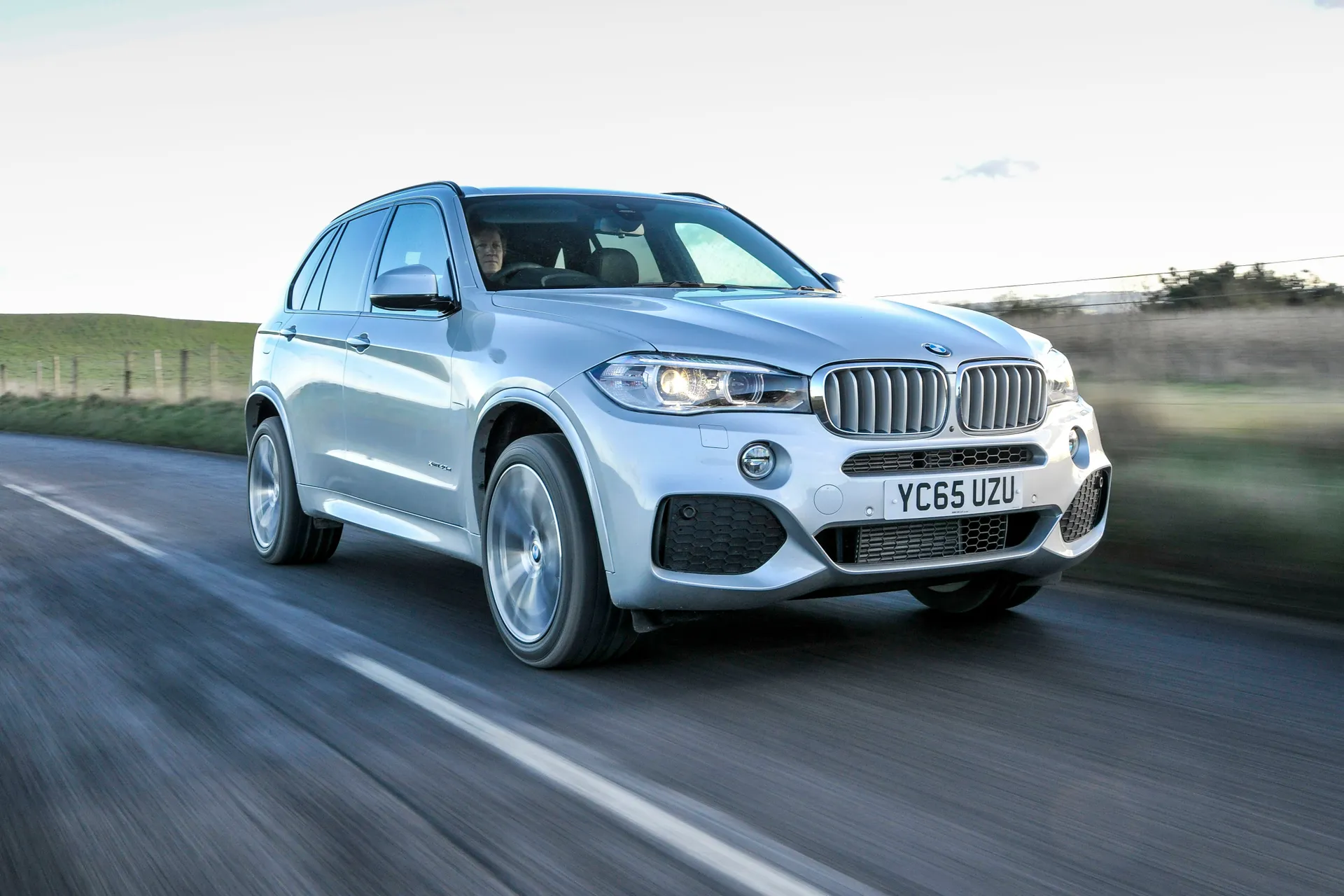
It doesn’t take long to discover what an eager machine this is. The well-weighted steering is responsive, it turns eagerly through corners rather than wallowing into them, and the general responsiveness will be a revelation if you’re used to more traditional SUVs.
Typically for BMW, several grades of suspension are available. The standard set-up is fully conventional and non-adjustable. An Adaptive Comfort option offers dynamic dampers and air suspension. You can alter the firmness by using the ‘Driving Experience Control’ button (it’s the toggle switch labelled ‘Sport’ and ‘Comfort’) next to the gear lever.
Adaptive M suspension is fitted to all BMW X5 M Sport versions, and includes the option of firmer Sport and Sport+ modes. BMW’s Adaptive Dynamic suspension includes the same suspension upgrade plus active anti-roll bars and a torque vectoring system. Ask the retailer which suspension set-up your prospective new car has.
We think the air suspension and adaptive damper upgrade is well worth it. There’s a step up in comfort, particularly at higher speeds, but handling becomes more precise and controlled as well. When you have an SUV that drives as eagerly as the X5, this is a particularly welcome trait.
Don’t get us wrong, standard models are still good – it’s just they don’t quite have the range of versions with more sophisticated suspensions, and will get caught out more easily by undulating or broken roads.
Ride quality is generally firm but absorbent. The X5 isn’t as supple as a Mercedes-Benz, but it’s still comfortable, and those susceptible to car sickness might actually find the BMW a better bet. Again, the ride remains better for longer with the adaptive suspension.
A final note on sDrive rear-wheel-drive versions. These are not as complete as the xDrive versions in the wet: the rear wheels are more eager to spin, so the electronic stability systems will kick in a bit more. They also have much less winter road ability. The fuel savings are welcome, but an xDrive X5 is a better all-weather, all-year-round vehicle.
What engines and gearboxes are available in the BMW X5?
BMW offers a range of engines well suited to the demands of a big SUV such as the X5. The entry-level engine is a four-cylinder 2.0-litre turbodiesel in the 25d, which produces 218PS. Aided by the eight-speed automatic gearbox (fitted as standard to all X5 models), it accelerates from 0-62mph in a perfectly credible 8.2 seconds. Both xDrive and sDrive versions have the same acceleration times, and the 25d is the only X5 offered with a two-wheel-drive option.
The core BMW X5 xDrive30d is a great all-rounder. It’s quieter and smoother in this generation of X5 than earlier versions, and offers more than enough acceleration (0-62mph takes 6.8 seconds) and response than most (thanks in part to that smooth-shifting gearbox). Those who want more power should choose the 40d, which hits 62mph in just 5.9 seconds.
The V8 xDrive50i is fun, but irrelevant for many. More entertaining is the M50d tri-turbo diesel, which produces 381PS and cuts acceleration further to 5.3 seconds. On the road, it feels unstoppable: BMW also sold a 575PS X5 M petrol but, while this was vibrant, it required more input to go quickly than the mighty M50d. And consumed far more fuel.
The plug-in hybrid xDrive40e has a 245PS 2.0-litre turbo petrol engine, a 113PS electric motor and a battery pack good for 19 miles of electric driving. Zero to 62mph in 6.8 seconds is pretty impressive, although in pure electric mode you’re limited to a top speed of 75mph or until the batteries go flat.
Refinement and noise levels
The X5 is a generally refined car to drive, with executive levels of refinement. There’s a bit more wind and road noise than you get in a 5 Series saloon, which is inevitable given how it’s a taller, boxier car, but it’s not excessive. And if you’re going to hear an engine hum in the background, there are worse noises to hear than BMW’s smooth straight-six diesel.
The sDrive25d is also reasonably quiet, although the engine is gruffer and less refined under acceleration. At higher speeds, though, you’re unlikely to notice much difference. It’s a good machine for mile-munching on the motorway.
The bigger wheels popular on the X5 do generate a bit of road noise, which means there will be some background roar on poor-quality road surfaces such as concrete. Mostly though, it should be disturbance-free, and overall noise levels are as hushed as you would expect of an executive SUV.
Safety equipment: How safe is the BMW X5?
All BMW X5s come with a good haul of passive safety features, such as all-round airbags (including curtain airbags). New safety assist features were available too, such as lane-departure warning and an auto-brake collision avoidance system that detects pedestrians as well as other cars. It works at speeds up to 35mph.
The Driving Assistant Plus package offered further safety convenience features. Active cruise control with stop and go uses radar to maintain a safe distance from the car ahead on the motorway, even if its speed alters. It will even fully brake the vehicle to a standstill and then automatically get going again when the car ahead moves away. Emergency call as standard, automatically telephoning the emergency services in an accident, while a driver attention monitor keeps a check on drowsy motorists.
Unusually, Euro NCAP didn’t crash-test this generation of X5, so we don’t know if it would have scored a full five-star rating. Its predecessor was rated four stars and its successor scored a full five stars, while this generation of BMW 5 Series also scored five stars. We can therefore predict it would be a good performer, but we can’t say for sure.
Maximum EV range
The xDrive40e has a total EV range of 19 miles before it needs recharging. Recharging the lithium-ion batteries, which benefit from BMW’s expertise with the all-electric BMW i3, takes around four hours with a domestic socket, or just over two and a half hours with a BMW i Wallbox.
Top speed is limited to 75mph in all-electric mode. You can default to driving on pure electric with a MAX eDrive setting, although the quoted 19-mile range is very much a best-case scenario.
MPG and fuel costs: What does a BMW X5 cost to run?
"The sDrive25d model officially returned as much as 52.3mpg, and even the xDrive25d could top 50mpg. The smooth xDrive30d returned over 40mpg, and the xDrive40d actually matched the 30d for fuel economy, despite its extra power. At the top of the range, the M50d returns 36mpg and even the M50i doesn’t look too bad with an average of 29.1mpg. The X5 M manages just 24.4mpg."
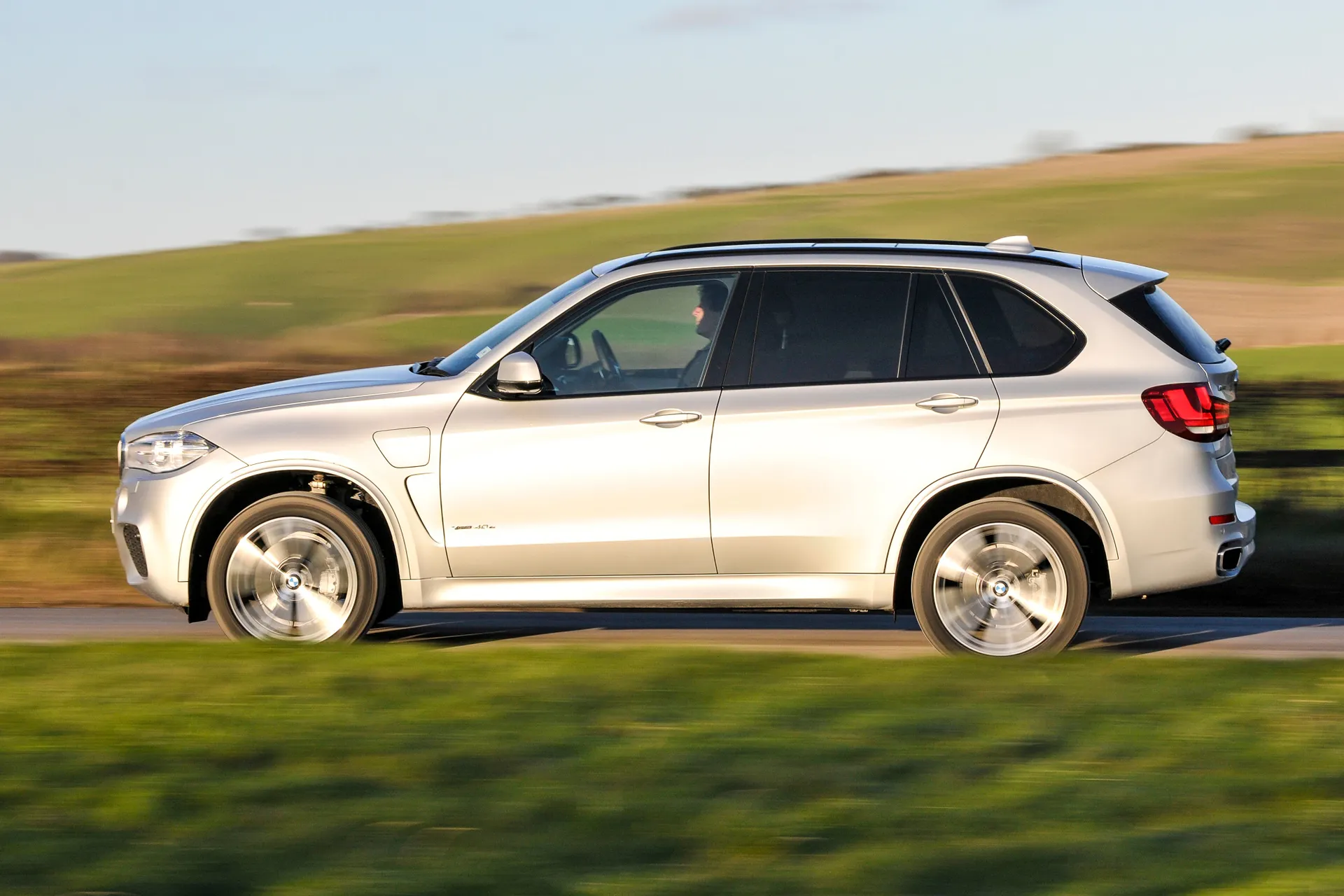
BMW diesel engines are known for producing better fuel economy figures than direct rivals. The X5 is a good example of this.
The BMW X5 sDrive25d model officially returned as much as 52.3mpg, and even the xDrive25d could top 50mpg. The smooth xDrive30d returned over 40mpg, and the xDrive40d actually matched the 30d for fuel economy, despite its extra power. At the top of the range, the BMW X5 M50d returns 36mpg and even the M50i doesn’t look too bad with an average of 29.1mpg. The X5 M manages just 24.4mpg.
The plug-in hybrid BMW X5 xDrive40e offers those who cover a low annual mileage the opportunity to slash their fuel costs – by charging on electric instead. If your commute is short, you may well be able to do it in pure electric mode, with the petrol engine there for when you take longer trips. It’s officially rated at 83.1mpg, although you’re unlikely to see this in practice.
How reliable is a BMW X5?
The BMW X5 scored an unremarkable 9.00 out of 10 for reliability in the HonestJohn.co.uk Satisfaction Index, which is middle-ranking compared to other BMW models and suggests it is not completely flawless in this respect.
As a brand BMW came 20th out of 30 manufacturers overall which is also pretty middling.
Insurance groups and costs
Premium SUVs invariably have higher insurance costs than cheaper, smaller alternatives. The lowest insurance group in the X5 range is the sDrive25d SE’s group 37 rating. M Sport models generally have a rating one group higher than SE, reflecting their flashier styling and perceived extra desirability. Our pick of the range, the xDrive30d, starts at group 42, with the xDrive40d M Sport rated at group 44.
VED car tax: What is the annual road tax on the BMW X5?
Because of their slightly lower CO2 emissions than the class norm, all BMW X5 models are generally a bit cheaper to tax than their direct rivals. The cheapest is the sDrive25d which, courtesy of 139g/km CO2 emissions, is a bargain £165 a year. The xDrive30d is a bit more expensive with an annual charge of £290 a year. Because it’s so closely matched on CO2, the xDrive40d costs the same.
The bargain of the bunch is the xDrive40e plug-in hybrid. With official CO2 emissions of just 77g/km, it’s rated Band A, so actually costs nothing to tax each year.
How much should you be paying for a used BMW X5?
"The 2014-era BMW X5 can now be bought via an approved used scheme for around £20,000. You shouldn’t find it too hard to come across a 25d or 30d SE for this amount, although M Sport and 40d versions will be rarer – you’ll probably have to spend from £25,000 for one of these, or accept higher miles than the 80,000-mile average currently on sale."
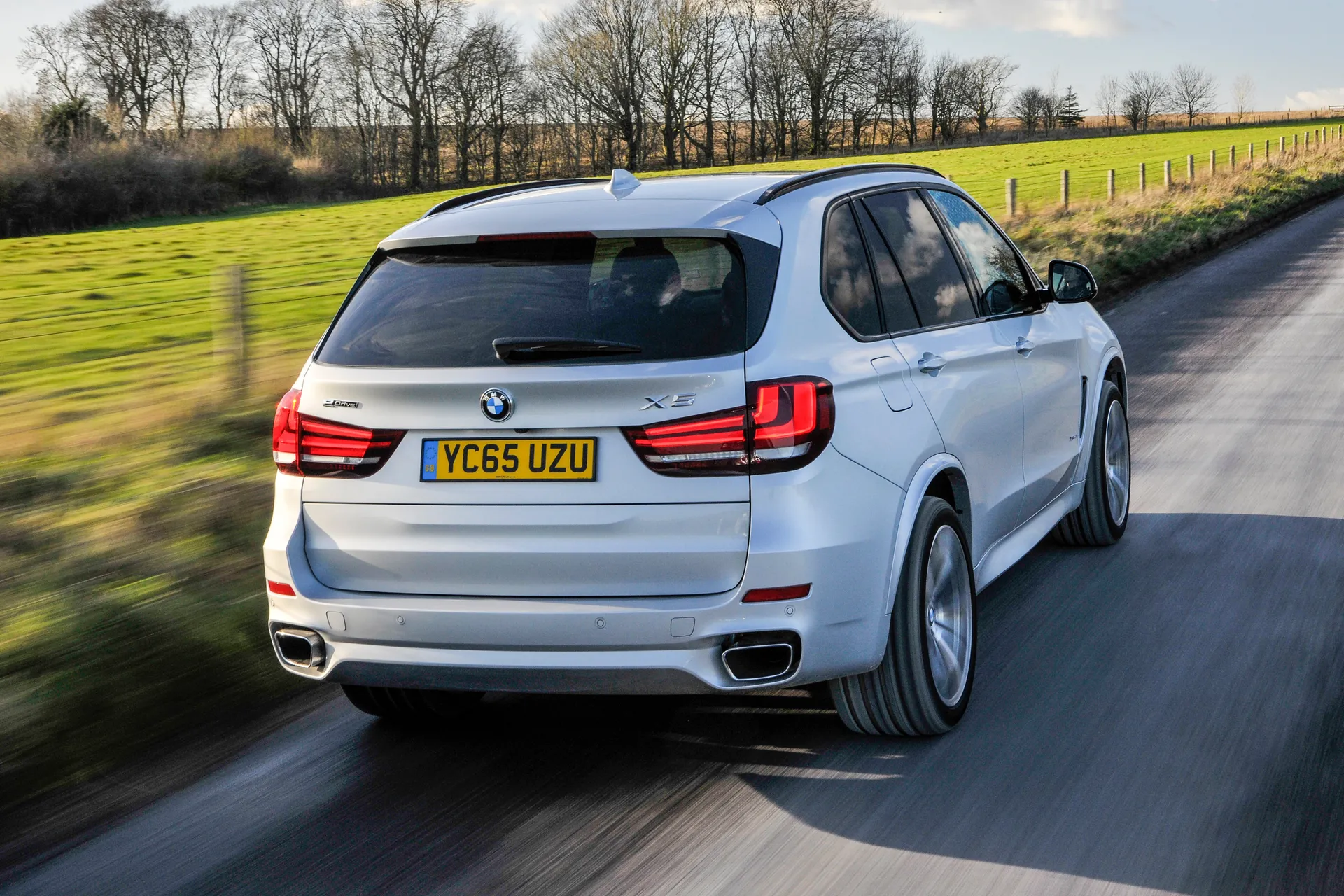
Indeed, prices can vary rather a lot because of the amount of desirable extras BMW offered when new. Not all of these will be worth much on the second-hand market, but features such as large alloy wheels, panoramic sunroofs and high-end infotainment systems will carry a premium. Desirable colours sell better than less popular hues such as white, too.
Trim levels and standard equipment
The BMW X5 was sold in two core guises throughout its lifetime: SE and M Sport. All models came as standard with the Professional Multimedia sat nav, climate control, eight-speed automatic gearbox, 18-inch alloy wheels and leather upholstery. M Sport versions have large alloy wheels, adaptive M suspension and an M-enhanced interior including nicer seats and a sportier steering wheel.
Ask the heycar experts: common questions
Is a BMW X5 considered a luxury car?
Is the BMW X5 a five or seven seater?
Is a BMW X5 a good purchase?
Get our latest advice, news and offers
Keep me updated by email with the latest advice, news and offers from heycar.
By submitting you agree to our privacy policy
